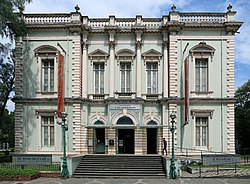Dr. Bhau Daji Lad Museum
Dr. Bhau Daji Lad Museum is the oldest museum in Mumbai. Situated in the vicinity of Byculla Zoo, Byculla East, it was originally established in 1855 as a treasure house of the decorative and industrial arts,[1] and was later renamed in honour of Dr. Bhau Daji Lad.
 Front view of the Dr. Bhau Daji Lad Museum | |
 Front view of the Dr. Bhau Daji Lad Museum | |
| Established | 2 May 1872 |
|---|---|
| Location | Veer Mata Jijabai Bhonsle Udyan, Dr. Baba Saheb Ambedkar Marg, Byculla East, Mumbai, Maharashtra 400027. |
| Coordinates | 18°58′46″N 72°50′05″E / 18.979472°N 72.834806°E |
| Director | Tasneem Zakaria Mehta |
| Website | www |
HistoryEdit
Lord Elphinstone established the Central Museum of Natural History, Economy, Geology, Industry and Arts, the first museum in Bombay in 1855; George Buist took the major initiative for its inception. In 1857, it was closed to the public and its collection was shifted to the Town Hall. In 1858, George Birdwood was appointed curator of the museum. Soon, a committee was formed, comprising him, Bhau Daji Lad and Jaganath Shunkerseth to raise money for construction of a new building for the museum. The foundation of the new building was laid in 1862. It was built with the patronage of many wealthy Indian businessmen and philanthropists like David Sassoon, Sir Jamsetjee Jejeebhoy and Jaganath Shunkerseth.
The construction of the present building in Jijamata Udyan in Byculla started in 1862 and was completed in 1871.[2] The museum was opened on 2 May 1872 as The Victoria and Albert Museum, Bombay. In 1975, this museum was renamed as The Dr. Bhau Daji Lad Mumbai City Museum.
In 2003, the Indian National Trust for Art and Cultural Heritage (INTACH) in collaboration with the Jamnalal Bajaj Foundation and the Municipal Corporation of Greater Mumbai undertook extensive refurbishment of the building.[3][4]
After five years of painstaking and intensive work, the Museum reopened to the Public on 4 January 2008.
Awards and RecognitionEdit
In 2005, the Museum won Unesco’s Asia-Pacific Award of Excellence in Cultural Conservation after being restored by conservation architect Vikas Dilawari.[1]
In 2016, the Museum received the International Quality Crown award in the gold category for its focus on quality, continuous innovation, and customer satisfaction.[2]
GovernanceEdit
The Museum is managed by a public-private partnership, a first for a cultural institution in India. The partnership involves the Municipal Corporation of Greater Mumbai, the Jamnalal Bajaj Foundation and the Indian National Trust for Art and Cultural Heritage (INTACH).[5]
Tasneem Zakaria Mehta is the Honorary Director of the Museum and has a Board of Management and Trustees that include the Mayor and the Municipal Commissioner of Mumbai.[6]
CollectionsEdit
This museum houses a large number of archaeological finds, maps and historical photographs of Mumbai, clay models, silver and copper ware and costumes. Its significant collections include a 17th-century manuscript of Hatim Tai[7] It also houses the iconic Kala Ghoda statue. Outside the museum is the installation of the monolithic basalt elephant sculpture recovered from the sea, which originated from Elephanta Island (Gharapuri Island).
GalleryEdit
Lua error in Module:Gallery at line 124: attempt to call field '_warning' (a nil value).
ReferencesEdit
- ↑ Hoskote, Ranjit (7 September 2005). "Honour for a treasure trove of art". The Hindu. Retrieved 27 June 2009.
- ↑ "PLACES". Maharashtra State Gazetteers-Greater Bombay District. Archived from the original on 14 June 2011.
- ↑ "Bhau Daji Lad museum to be finally inaugurated". The Indian Express. 2 January 2008. Retrieved 27 June 2009.
- ↑ "Mumbai's oldest museum looks to the future". Apollo Magazine. 25 August 2017. Retrieved 15 March 2019.
- ↑ "Dr. Bhau Daji Lad Museum - The Tripatriate Agreement". Dr. Bhau Daji Lad Museum website. Archived from the original on 22 March 2012. Retrieved 7 September 2011.
- ↑ "The Tripatriate Agreement". Dr. Bhau Daji Lad Museum official website. Archived from the original on 22 March 2012. Retrieved 13 September 2011.
- ↑ Koppikar, Smruti (21 January 2008). Passage to Bombay in Outlook, Vol.XLVIII, No.3, pp.61-3.
